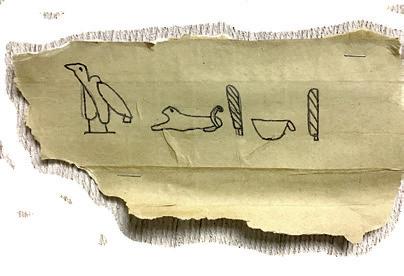
4 minute read
Garden
Borderite ReportTHE Brought To You By The Blaine School District Point Roberts Primary 2050 Benson Rd, P.O. Box 910 Point Roberts, WA 98281 945-ABCD (2223)
TEACHER’S CORNER
Advertisement
Students at Point Roberts Primary have continued learning about the amazing world we live in. Last month students learned about Ancient Egypt. During our studies the students learned about how the Egyptians lived. They made their own papyrus (paper), wrote their names in Egyptian hieroglyphs, excavated artifacts from Egyptian Artifact kits, learned how to draw 3-D pyramids and painted beautiful desert scenes by incorporating warm colors from the color wheel.
Next stop... Australia!
Jessie Hettinga, M.S.Ed.
Principal/K-3 Teacher, Point Roberts Primary 360-945-2223 * jhettinga@blainesd.org
Ahlan! “Hello from Egypt”
by Emmett
by Alice

by Naève

by Jasmine by Riley by Damian
“The world is a book, and those who do not travel read only a page.” - Augustine of Hippo
Check out our district website! www.blainesd.org
B y r hiann O n a llen
A recent discussion of native plants (via the Washington Native Plant Society, I think) led me to check out Hitchcock and Cronquist’s Flora of the Pacific Northwest. When this hefty tome arrived at the Library, I admit that I was disappointed. When I think of the word ‘flora,’ I think of the parts of the plants easily visible to the naked eye. But this book was a detailed compendium of plants found in the Pacific North West wilds, with a distinct focus on seeds. It took me a while to determine the precise source of my disappointment.
Years ago, a friend looked around my garden and surmised, “You like foliage.” I’m not sure that she meant this as an insult, but it gave me pause. Yes, I do like foliage. I mean, flowers have their place. I love the flush of spring flowers in my rockery. I hope to make it once again to the Skagit Valley Tulip Festival with its fabulous floral colors. And of course, there are particular flowers that I am fond of, such as the Hellebores that are blooming right now.
But what touches my heart is the amazing variety of greenery in forests, open spaces and gardens. Moreover, I tend to rely on foliage to identify a plant. To me, the flowers are a bonus, but not always the driving force in selecting plants for my garden. As I write this in late winter, I can look out my office window and see what delights me. The gray-green leaves of a sprawling Senecio Brachyglottis ‘Sunshine’ planted to screen a propane tank. The persistent greenery of wallflowers that will later burst forth with flowers. A golden aromatic evergreen. The perky leaves of rhododendrons. The gold and chartreuse blades of Acorus (sweet flag). The persistent green backdrop of Western red-cedars and Douglas firs skirted with sword ferns, without which our winter landscapes would be bleak. These give pleasure all year.
Of course, not all that is green gives pleasure. I find that recognizing foliage is a key to successful weeding. Is that spot of green the hated weedy popweed (Cardamine hirsuta) that I must rip out before it sprays its horrid seeds far and wide? Or is it mâche (corn salad) destined for the winter sal(See Garden, page 11)

Centennial of the Maple Beach jitney service
B y M ark s wens O n
As we welcome back more and more Canadians to the Point, it’s timely to commemorate the centennial of bus service between Ladner and Maple Beach, which helped to make the Point a recreation destination for Canadians.
Canadians have come to Maple Beach for recreation since the 19th century, but getting here from Vancouver was not easy. The Delta Optimist complained about how hard it was to get to Boundary Bay on September 17, 1910: “Popular as the district is at present as a summer resort, its popularity would be greatly increased were the disadvantage of inaccessibility removed ... and Vancouver brought within two hours’ distance.”
for REAL news READ LOCAL
Find ways to support your continued local news coverage at: AllPointBulletin.com
Prior to the opening of the Deas Island tunnel in 1959, people had to cross the Fraser River at New Westminster, or take a ferry from Richmond to Ladner. Initial passenger ferries sailed twice a day yearround (with a third daily sailing in the summers) to Ladner from Steveston, and in 1913 a small car ferry was introduced, which sailed from Woodward’s Landing.
A larger 40-car ferry wasn’t introduced until the 1930s, which meant in the early years there were many passengers arriving on foot in Ladner who still needed a ride to Maple Beach. To serve this demand, in 1922 the White Star Motor Company began bus service between Ladner and Maple Beach. These 10-seat jitneys met each ferry in Ladner – the old ferry dock can still be seen at the Ferry Road boat ramp – and shuttled folks to Boundary Bay.
The ability for more and more Vancouverites to reach our warm beaches spurred the development of Maple Beach, and Point Roberts in general. Soon, locals were subdividing homesteads for cottage-sized lots, offering summer rentals and opening beachside businesses. Boundary Bay earned a reputation that the Vancouver World newspaper heralded as the “coming summer resort.”
A century later, Maple Beach remains a popular summer destination. Stop in Saturdays at the Point Roberts History Center on Gulf Road to see displays about the development of Maple Beach, driven in part by the jitney service which began 100 years ago.


